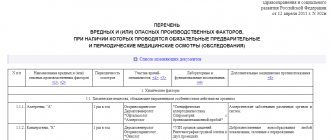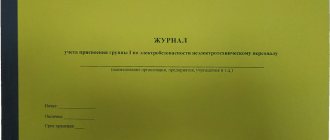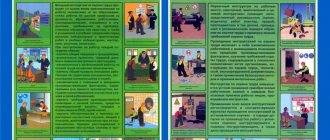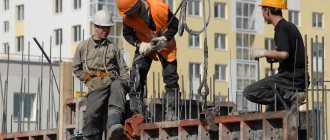Workers in some professions cannot be allowed to perform work without undergoing an internship - training an employee under the guidance of a more experienced mentor. An order for admission to independent work is issued at the end of the internship and serves as proof of its successful completion. Files in .DOC: Form of order for admission to independent workSample order for admission to independent work
How to properly arrange an internship at the workplace
Proper registration of permission to perform official duties is considered an important component of safety, therefore the administration of the enterprise stipulates this point in the employment agreement. The management of the organization, represented by the employer, regulates that before starting independent work, it is necessary to acquire certain experience and skills in order to avoid negative consequences.
Sequence of labor organization
For this purpose, an administrative document is issued that approves the local act. The regulatory framework of the enterprise establishes the rules for conducting internships for employees.
Important! There is no specific form of the document; therefore, the employer can create his own at his personal discretion or take an approximate sample from Internet resources.
The regulation or standard for employee training before being allowed to work should include the following information:
- What goals are pursued during the internship?
- What position will the intern be in?
- How are the working hours of a newly hired employee and his immediate mentor paid?
- Algorithm for completing industrial training.
- According to what documents the activities of the person conducting the internship are regulated.
The local document is prepared earlier, and in the appendix there is a list of positions of employees who need an internship. According to the requirements of the rules, professions such as slinger or boiler room operator, driver, as well as those working in electrical installations and at heights are required to undergo training and be allowed to perform duties after completing the document.
Certificate
Internship program
The internship of employees is carried out according to a program developed taking into account the specifics of the company’s field of activity and professional nuances relevant to a specific specialty.
It usually differs for workers of different professions. The document must reflect the purpose for which the event is being carried out, as well as its objectives. The regulations should mention the rights of the trainee, his duties, responsibilities, the temporary period of training and the procedure for remuneration during this period. It also needs to display the procedure for obtaining admission.
Internship order
Before initiating an internship, the employer must make sure that the applicant meets the requirements reflected in the job description. It is necessary to check educational documents and study the work book, the contents of which will reveal information about the person’s work experience. It is recommended to make sure that there are no reprimands and pay attention to the reason for dismissal from previous jobs. When employing a person for responsible positions, a reference may be required. A person cannot be allowed to work in some professions without a medical examination, so the employer must make sure of the person’s professional suitability before starting the internship, since a person’s illness can cause a waste of his and the employer’s time on training.
If the specifics of an employee’s activity presuppose the need to obtain additional education with qualifications, then, if possible, obtaining it can be combined with an internship.
Sample order for permission to work
Order on labor protection in an organization, sample
An order for permission to work independently, a sample of which can be found on the Internet, looks like this. There are three sections in the document: preamble, administrative part and conclusion. Each company can develop its own form, which will be optimally convenient. The order for admission to independent work, including its sample, is approved by an administrative act.
When compiling, you can use the following recommendations:
- Indicate the details of the company where the internship is required. To do this, you can use the organization’s unified form.
- Write down the name of the order and leave space for assigning a number.
- Indicate the date of signing.
- The preamble indicates the part that motivates the employee to complete the internship. This may be a reference to regulatory documents and legislative acts. The purpose of the execution must also be clearly stated.
Sample
- Last name and initials of the person who is allowed to perform duties.
- Date when the internship ends. That is, after this date, the worker will be responsible for his own actions, including for his own safety and the safety of his employees.
- If you have taken courses or passed exams in the field of internship, you must indicate the regulatory documents.
- Indicate who should control the execution of this document.
- Date and signature of the manager.
Need to know. The issued administrative document must be signed by the person who conducted the internship and the employee allowed to work.
The date must be placed next to the signature, otherwise the document is considered invalid.
Training in safe work practices
There are certain types of professions for which on-the-job training is not required, but training in safe methods and techniques for performing work becomes mandatory.
How is it carried out? The rules don't clearly say this. The Ministry of Labor says that the organization of this type of training is carried out at the discretion of the head of the organization. Therefore, you can send your employees to a specialized training center, or invite specialists, or organize this training at your workplace.
This type of training is carried out no later than 1 month during the employee’s employment.
A training program must be developed. It usually consists of five sections:
- labor law / we talk about workers’ rights and responsibilities;
- labor protection / we analyze all internal local documents;
- Fire safety;
- electrical safety;
- providing first aid to victims.
In what cases is it issued?
Order of the Ministry of Transport No. 59: driver training
To gain experience and skills in production activities, employees must undergo an internship. This time of the labor period is aimed at studying the technological process, production site and equipment used in completing the task.
The need to carry out is mandatory for the following cases:
- If employment occurs for the first time. For example, a technical school student has graduated from an institution and needs to start working; he does not know many of the nuances; therefore, he undergoes additional training directly at the place of work.
- If the working conditions, based on the results of the special assessment, are classified as working with harmful substances or hazardous factors. In this case, it is necessary to work under the clear guidance of an experienced employee. Otherwise, injury or occupational illness cannot be ruled out. You can’t do this without an experienced mentor.
- The worker, due to some circumstances, moved to a new place, although he remained in the same organization. Working conditions have changed, so it is necessary to familiarize yourself with the peculiarities of the workplace.
Decor
Need to know. For all of the above cases, an internship is required, so the enterprise administration will protect itself from possible negative consequences.
Methodological recommendations for organizing training on labor protection for workers
The list of professions and positions of employees exempt from internship must be approved by the employer and agreed upon with the trade union committee (or other representative body of employees).
3. The internship is carried out under the supervision of a responsible training person. Internships for workers in blue-collar professions can be supervised by foremen, foremen and other qualified workers who have at least 3 years of practical work experience in this profession, and internships for specialists can be supervised by specialists of higher qualifications and with at least 3 years of practical work experience or heads of structural units. divisions. The supervisors of internships for blue-collar workers are determined by the head of the structural unit, and the supervisors of internships for specialists are determined by the employer.
The appointment of an internship supervisor is formalized by an appropriate order (instruction) (Appendix 2.2). The internship supervisor and the employee must be familiarized with the order (instruction) against signature.
We recommend reading: If a child has disabilities, can they allocate an apartment to their parents?
4. The duration of the internship from 2 to 14 shifts (working days) is established by the head of the structural unit, depending on the nature of the work and the qualifications of the employee. The internship is carried out according to developed programs for conducting initial instruction at the workplace, in the scope of approved production instructions, labor protection instructions, as well as job responsibilities. After the internship, the internship supervisor must: - check the acquired information orally or in writing;
How documentation is prepared after the internship
Order on fire safety and procedures for employees
After acquiring skills and experience in the work, the employee must be officially allowed to perform official duties, for this the following is done:
- In accordance with the requirements, an administrative act is issued at the enterprise. The content part indicates the full initials, the start and end dates of the internship and when you can begin independent work.
- The site or team manager is responsible for testing acquired knowledge, including how to safely operate equipment or how to walk around the site.
- The admission order must be signed in person and dated.
You can begin to perform your duties from the date specified in the administrative document.
Rostekhnadzor explains: Permitting personnel to work at substations
Question from 04/30/2020:
A car repair mechanic is hired to work on a railway crane (he is trained). How should admission and internship be properly completed?
Answer: According to clause 1.1 of the List of works, during the performance of which mandatory preliminary and periodic medical examinations (examinations) of workers are carried out, such medical examinations are carried out in relation to workers performing work at height, work on servicing lifting structures, including work as a crane operator (driver). crane).
According to Part 1 of Article 225 of the Labor Code of the Russian Federation, all employees, including heads of organizations, as well as employers - individual entrepreneurs, are required to undergo training in labor protection and testing of knowledge of labor protection requirements in the manner established by the federal executive body authorized by the Government of the Russian Federation, taking into account opinions of the Russian Tripartite Commission for the Regulation of Social and Labor Relations.
According to Part 2 of Article 225 of the Labor Code of the Russian Federation, for all persons entering work, as well as for workers transferred to another job, the employer or a person authorized by him is obliged to provide instructions on labor protection, organize training in safe methods and techniques for performing work and providing first aid to victims.
According to Part 3 of Article 225 of the Labor Code of the Russian Federation, the employer provides training for persons entering work with harmful and (or) dangerous working conditions in safe methods and techniques for performing work with on-the-job training and passing exams and conducting periodic training on labor protection and testing of knowledge labor protection requirements during work.
According to clause 2.1.1 of the Resolution of the Ministry of Labor of Russia, the Ministry of Education of Russia dated January 13, 2003 N 1/29 (as amended on November 30, 2016) “On approval of the Procedure for training in labor protection and testing knowledge of labor protection requirements for employees of organizations” (registered with the Ministry of Justice of Russia 02/12/2003 N 4209) (hereinafter referred to as Resolution N 1/29) for all persons hired, as well as for employees transferred to another job, the employer (or a person authorized by him) is obliged to provide instructions on labor protection.
According to clause 2.1.2 of Resolution No. 1/29, all persons hired... and other persons participating in the production activities of the organization undergo induction training in the prescribed manner, which is conducted by a labor protection specialist or an employee for whom the order of the employer (or authorized persons) are entrusted with these responsibilities.
Introductory training in labor safety is carried out according to a program developed on the basis of legislative and other regulatory legal acts of the Russian Federation, taking into account the specifics of the organization’s activities and approved in the prescribed manner by the employer (or his authorized person).
According to clause 2.1.3 of Resolution No. 1/29, in addition to introductory briefing on labor protection, initial briefing at the workplace, repeated, unscheduled and targeted briefings are carried out.
Initial briefing at the workplace, repeated, unscheduled and targeted briefings are carried out by the immediate supervisor (producer) of the work (foreman, foreman, teacher, etc.), who has undergone occupational safety training in the prescribed manner and tested knowledge of labor safety requirements.
Conducting labor safety briefings includes familiarizing workers with existing hazardous or harmful production factors, studying labor safety requirements contained in the organization’s local regulations, labor safety instructions, technical and operational documentation, as well as the use of safe methods and techniques for performing work.
The labor safety briefing ends with an oral assessment of the employee’s acquired knowledge and skills in safe work practices by the person conducting the briefing.
Conducting all types of briefings is registered in the relevant logs of briefings (in established cases - in the work permit) indicating the signature of the person being instructed and the signature of the instructing person, as well as the date of the briefing.
According to clause 2.2.1 of Resolution No. 1/29, the employer (or a person authorized by him) is obliged to organize, within a month after hiring, training in safe methods and techniques for performing work for all persons entering work, as well as persons transferred to another job.
Labor safety training is carried out during the training of workers in blue-collar professions, retraining and training them in other blue-collar professions.
According to clause 2.2.2 of Resolution No. 1/29, the employer (or a person authorized by him) provides training for persons hired in harmful and (or) dangerous working conditions in safe methods and techniques for performing work with on-the-job training and passing exams, and in the course of work - conducting periodic training on labor protection and testing knowledge of labor protection requirements. Workers in blue-collar professions who are new to these jobs or who have had a break in their profession (type of work) for more than a year undergo training and testing of knowledge of labor protection requirements within the first month after being assigned to these jobs.
According to clause 2.2.3 of Resolution No. 1/29, the procedure, form, frequency and duration of training on labor protection and testing knowledge of labor protection requirements for workers in blue-collar professions are established by the employer (or his authorized person) in accordance with regulatory legal acts governing the safety of specific types works
According to clause 2.2.4 of Resolution No. 1/29, the employer (or a person authorized by him) organizes periodic, at least once a year, training for blue-collar workers in providing first aid to victims. Newly hired employees undergo training in providing first aid to victims within the time frame established by the employer (or a person authorized by him), but no later than one month after hiring.
According to clause 3.1 of Resolution No. 1/29, testing of theoretical knowledge of labor protection requirements and practical skills of safe work of workers in blue-collar professions is carried out by immediate supervisors of work to the extent of knowledge of the requirements of rules and instructions on labor protection, and, if necessary, to the extent of knowledge of additional special safety requirements and labor protection.
According to clause 3.4 of Resolution No. 1/29, in order to test knowledge of labor protection requirements for workers in organizations, by order (instruction) of the employer (manager), a commission is created to test knowledge of labor protection requirements, consisting of at least three people who have undergone training in labor protection and testing of knowledge labor protection requirements in accordance with the established procedure.
According to clause 3.7 of Resolution No. 1/29, an employee who has successfully passed the test of knowledge of labor protection requirements is issued a certificate signed by the chairman of the commission for testing knowledge of labor protection requirements, certified by the seal of the organization (if there is a seal) that conducted the training in labor protection and testing of knowledge of the requirements labor protection, in the form in accordance with Appendix No. 2 to the Procedure.
Rules for labor protection when working at height were approved by Order of the Ministry of Labor and Social Protection of the Russian Federation dated March 28, 2014 N 155n (hereinafter referred to as the Rules).
According to clause 5 of the Rules, persons over the age of eighteen are allowed to work at height.
According to clause 6 of the Rules, workers performing work at height, in accordance with current legislation, must undergo mandatory preliminary (upon entry to work) and periodic medical examinations.
According to clause 7 of the Rules, workers performing work at height must have qualifications corresponding to the nature of the work performed. The level of qualification is confirmed by a document on professional education (training) and (or) qualifications.
According to clause 8 of the Rules, workers are allowed to work at height after:
- a) training and testing knowledge of labor protection requirements;
- b) training in safe methods and techniques for performing work at height.
Industrial safety requirements for organizations and employees of hazardous production facilities operating lifting structures are approved by Rostekhnadzor Order No. 533 dated November 12, 2013 (as amended on April 12, 2016) “On approval of Federal norms and rules in the field of industrial safety “Safety Rules for Hazardous Production Facilities” on which lifting structures are used" (registered with the Ministry of Justice of Russia on December 31, 2013 N 30992).
According to clause 26 of the Requirements, employees of hazardous production facilities directly involved in the operation of the substation must meet the following requirements:
- a) be trained and have a certificate issued in the prescribed manner for the right to work independently in the relevant types of activities;
- b) know the performance criteria of the applied substations in accordance with the requirements of the manual (instructions) for the operation of the applied substations, the technological process of transporting goods;
- c) in the event of a threat of emergency, inform your immediate supervisor about it;
- d) know the procedure for following the instructions of the operating organization in the event of accidents and incidents during the operation of the substation, and also follow these instructions;
- e) undergo certification in the prescribed manner (for specialists only) for knowledge of these FNP and not violate them in the process of performing work.
The rules for labor protection during the operation of electrical installations were approved by Order of the Ministry of Labor of Russia dated July 24, 2013 N 328n (as amended on November 15, 2018) “On approval of the Rules for labor protection during the operation of electrical installations.”
The information is not exhaustive.
D. Rodionova
Question from 04/28/2017:
What documents obtained from a training organization must a slinger present when applying for a job in the organization? Does the organization have the right to issue a certificate for admission to sling work if, when hired, the applicant provided only a certificate of qualification and rank?
Answer: In accordance with Part 1 of Article 9 of the Federal Law of July 21, 1997 No. 116-FZ “On Industrial Safety of Hazardous Production Facilities” | One of the responsibilities of an organization operating a hazardous production facility is the following:
allow persons who meet the relevant qualification requirements and do not have medical contraindications to the specified work to work at a hazardous production facility. This requirement also applies to slingers.
Assignment of slinger qualifications to workers is carried out after undergoing training in accordance with the established procedure in organizations that have licenses to conduct educational activities. Workers who have successfully completed training and passed the qualification exam are issued appropriate documents confirming completion of training and assignment of qualifications.
In accordance with subparagraph “b” of paragraph 150 of the Federal norms and rules in the field of industrial safety “Safety rules for hazardous production facilities that use lifting structures”, approved by Rostechnadzor order No. 533 dated November 12, 2013, registered with the Ministry of Justice of Russia on December 31, 2013 No. 30992, organizations operating lifting structures must ensure the established procedure for admission to independent work (personnel) with the issuance of appropriate certificates, which indicate the type of lifting structure, as well as the types of work and equipment for which they are allowed to work.
Based on the above, when hired by an organization, a slinger presents documents confirming that he has completed training and has been awarded the qualifications of a slinger, on the basis of which the organization issues him an appropriate certificate. In this case, the procedure for admitting a slinger to independent work is carried out in accordance with the procedure established in the organization. And at the same time, the form of personnel identification is not established by industrial safety requirements, and is determined by the operating organization.
Question from 08/30/2014:
CJSC Energomash (Ekaterinburg) - Uralelectrotyazhmash operates a hazardous production facility (industrial buildings) - a production site for electrical products (hazard class IV) and technical devices - overhead cranes installed in these buildings. The company's staff consists of mechanics and electricians for cranes, specialists responsible for production control during the operation of lifting structures (PS) and for their maintenance in working order.
At the specified production site there are production sites of another legal entity. Elmash LLC. Its staff includes personnel trained and certified for the operation of substation: overhead crane operators, slingers, specialists responsible for the safe performance of work using substation.
Please clarify, can the operating organization allow the specified personnel of another legal entity to work at the substation, subject to compliance with the requirements of the Federal norms and regulations in the field of industrial safety “Safety Rules for Hazardous Production Facilities Where Lifting Structures Are Used”?
A.A. Zyabrev, technical director of JSC Energomash (Ekaterinburg) - Uralelectrotyazhmash
The head of the State Construction Supervision Department of Rostechnadzor A.N. answers the reader’s question. Gorlov.
Since March 7, 2014, Federal norms and rules in the field of industrial safety “Safety rules for hazardous production facilities that use lifting structures” (hereinafter referred to as the FNP for PS), approved by order of Rostechnadzor dated November 12, 2013, have been in force on the territory of the Russian Federation No. 533, registered by the Ministry of Justice of Russia on December 31, 2013, registration No. 30992.
Clause 26 “a” of the FNP on PS determines that employees of hazardous production facilities (HIF) directly involved in the operation of lifting structures (PS) must be trained and have a certificate issued in the prescribed manner for the right to work independently. In addition, in accordance with clause 150 “b” of the FNP for substations, operating organizations are obliged to ensure the maintenance of substation in working order and safe operating conditions by organizing proper supervision and maintenance, technical examination and repair. For these purposes, the procedure for certification (of specialists) and admission to independent work (of personnel) must be ensured, with the issuance of appropriate certificates that indicate the type of substation, as well as the types of work and equipment for which they are allowed to work. The form of the certificate for the right to independent work is established by the organization that operates the PS independently (the FNP for the PS does not establish the form of such a certificate).
Based on the above, the organization operating the hazardous production facility with the substation permits the personnel servicing the substation to work with the issuance of a certificate for the right to work independently. This requirement must also be met when service personnel from another organization are allowed to work at a hazardous production facility with a substation. At the same time, according to clause 23 “g” of the FNP for PS, the involvement of an employee of another organization to perform the duties of a specialist responsible for the safe performance of work using the PS is not allowed (only specialists from the organization operating the hazardous production facility with the PS are appointed).
Question from 07/30/2014:
On March 7, 2014, {30-Federal norms and rules in the field of industrial safety “Rules for the safety of hazardous production facilities that use lifting structures” (hereinafter referred to as the FNP for PS) came into force. The requirements for the form and content of certificates are not established by these FNP for PS.
Young workers with diplomas of primary vocational education come to find employment at Mining Equipment Repair Plant LLC. In their diplomas they were assigned the following qualifications: drilling rig operator, electric mechanic (fitter) on duty and equipment repair, electric and gas welder, slinger. Please clarify, is it possible to allow workers to work independently in the professions listed in the diploma of primary vocational education, or should they be issued the appropriate separate certificates? If not, then based on what regulatory document?
A.L. Shalagin, acting Ch. engineer at Mining Equipment Repair Plant LLC
The head of the State Construction Supervision Department of Rostechnadzor A.N. answers the reader’s question. Gorlov.
Training and testing of knowledge of personnel serving lifting structures (PS) is carried out in accordance with the Regulations on the organization of training and testing of knowledge of working organizations supervised by the Federal Service for Environmental, Technological and Nuclear Supervision (RD-03-20—2007), approved by order of Rostechnadzor dated 29 January 2007 No. 37 “On the procedure for training and certification of employees of organizations supervised by the Federal Service for Environmental, Technological and Nuclear Supervision”, registered by the Ministry of Justice of Russia on March 22, 2007, registration No. 9133.
Since March 7, 2014, the Federal norms and regulations in the field of industrial safety “Safety rules for hazardous production facilities that use lifting structures” (hereinafter referred to as the FNP for PS), approved by order of Rostechnadzor dated November 12, 2013, have been in force on the territory of the Russian Federation. No. 533, registered by the Ministry of Justice of Russia on December 31, 2013, registration No. 30992.
Clause 26 “a” of the Federal Tax Code for Substation Items stipulates that employees of hazardous production facilities directly involved in the operation of substation systems must be trained and have a certificate issued in the prescribed manner for the right to work independently. In addition, in accordance with clause 150 “b” of the FNP for substations, operating organizations are obliged to ensure the maintenance of substation in working order and safe operating conditions by organizing proper supervision and maintenance, technical examination and repair. For these purposes, a procedure for certification (specialists) and admission to independent work (staff) must be ensured, with the issuance of appropriate certificates that indicate the type of substation, as well as the types of work and equipment for which they are allowed to work. The form of the certificate for the right to independent work is established by the organization that operates the PS independently (the FNP for the PS does not establish the form of such a certificate).
Based on the above, after training personnel in accordance with the requirements established by RD-03-20—2007, the organization operating a hazardous production facility with a substation carries out, in accordance with the FNP for substation, access to work for personnel servicing the substation with the issuance of a certificate for the right to independently work.
When an order is signed
An order or order for permission to perform production duties is signed after the following actions are completed:
- After being hired for a job or civil service, a trainee, that is, an employee with knowledge and experience, is assigned to a new position. This is regulated by the administrative document.
- In the process of mastering skills, a newly hired person (no matter a foreigner or a Russian) undergoes instruction and becomes familiar with the technical process and equipment for performing tasks, and is also informed about the pathogenicity of the effects of adverse factors (they may be drug-containing substances).
- During initial experience, the employee may be asked a number of questions to the immediate mentor or supervisor. Independent study of instructions, orders and other documents on occupational safety and the implementation of production tasks is also required.
- Acceptance of tests in the area of activity is organized. If the answers are correct, it is concluded that the material has been mastered in full, and the employee can be allowed to perform his duties. Removal from work is carried out in case of misunderstanding of the material covered and failure to pass the exam.
- An order for admission is issued. Signed by the site manager, direct mentor and newly hired employee.
Certification, admission, internship
Initial safety measures have been completed.
Worth considering. The trainee must also have knowledge and certification in the field of health and safety.
Who should do the internship?
An internship is not necessary for all employees, but only for those whose job responsibilities expose their body to harmful production factors.
Legal acts regulate the list of employees who need to organize training and practice, as well as the circumstances under which the procedure must be repeated. Internship is required for drivers who will transport passengers or cargo, as well as for employees in the energy field. During breaks in work, these specialists must undergo repeated training. For other professions, the need for an internship is determined by the employer.
At each enterprise, the responsible specialist must develop and approve a list of employees who must undergo internships when hired. It is also necessary to indicate the timing of the event. For managers and responsible specialists, the internship lasts from two weeks to a month. Employees who do not have work experience and qualifications can study for up to six months. Training for blue-collar workers with certain qualifications lasts up to three weeks. The same time is enough to resume existing skills after a break in work.
Where is the order registered?
An order stating that the internship has been completed and instructions given must be registered.
Recommended registration is carried out according to the following algorithm:
- Take a special journal in which there are columns.
- A serial number is indicated; it is possible that the administrative document is a personnel document, so the letter “K” is added to the numbering. For example, 19-K.
- The assignment date is entered.
The order has been registered and accepted for execution. Storage is carried out for 3 years.
If the internship is not completed
If the administrative act indicates the date when admission to work was expected and the employee did not pass the test or did not master production nuances, then in this case a new time is set for signing the order.
At production sites, unfavorable situations arise, that is, possible injury.
Important! When investigating an emergency situation, the list of required documents includes an order for permission to work, and if there is no document, this will be a violation.
A document confirming permission to work is required. This will protect management and employees from negative consequences.











